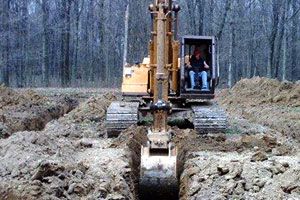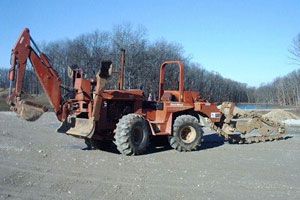Horizontal Loop Installation
First and foremost, it is never a good idea to try to put a horizontal loop into an area that it does not fit. The more ground contact the loop has, the better it works: in turn, the more ground area between the loops, the more heat they can exchange with it. Loop pipes too close together can heat up the ground or run the ground out of available heat depending on the season and the load. Slinky loops can save installation money and area, but they create the largest footprint of all loop fields. Some experts say that slinky loops can run warmer than traditional loops in extremely hot years. It is wise to round up on pipe length needed when considering a slinky loop field.

Bucket Trench

Slinky Trench
These two methods take up the smallest amount of space per ton of horizontal loop, but leave the biggest footprint on the landscape. These are most commonly placed in tilled fields, unused pastures, or areas where landscape is of minimal concern. These methods should not be used under high-lines. When operating, an excavator boom can exceed twenty feet in height.

A chain trench is the most common method of installing a horizontal loop field. A trench is cut 8-10" wide and about 6' deep. One half of a u-bend loop is placed in the bottom of the trench. 2 feet of dirt is then back-filled into the trench so that the other half of the u-bend can be placed into the trench at four feet depth. Tracer wire is installed in the trenches, and the rest of the back-fill is completed.
Although the trencher is a relatively small machine, please remember to allow enough space beside the trenches for the machine to push the dirt back in from both sides of the trench. In other words, we trench in the center of the machine, but while back-filling, we drive the machine on both sides of the trench. Also allow enough room at the end of the field to turn the machine around. The recommended distance between chain trenches is 8'-10'. Please keep in mind that this is a recommended minimum.
Chain trenchers prefer long straight parallel runs. They do best on flatter ground, but can work up and down hills. Trenchers are very top-heavy machines. They should NEVER be operated across a hill. Trenches cut into slanted ground are more likely to collapse as gravity pulls straight down on the unsupported dirt.
This method should not be used in pasture ground, yards where children play, or other places where tripping in uneven dirt settling can be an issue of concern. This method is also not to be used when a water, electric, or pipeline, etc. must be crossed multiple times.
Please keep in mind that horizontal piping, and supply and return headers must have a 25' setback from water wells in many states.